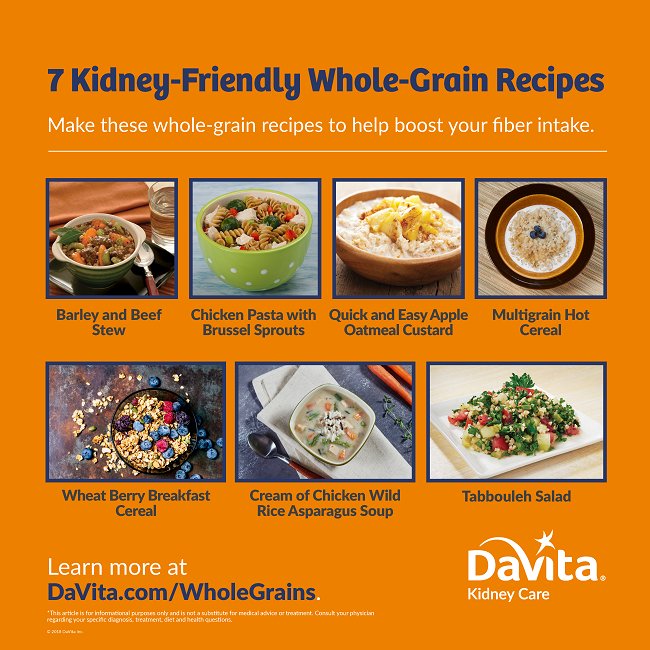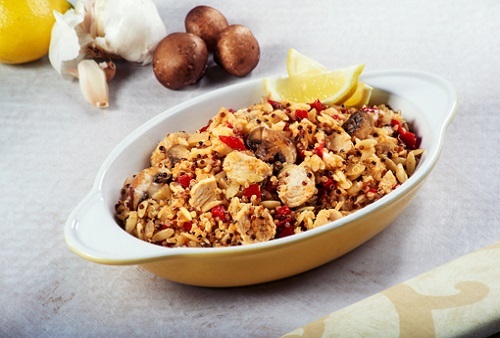Ancient Grains in Today’s Kidney Diet
There is confusion around whole grains and ancient grains in the kidney diet. The reason is changes in renal diet goals and guidelines. Read on to learn more about current kidney diet recommendations for grains.
New Whole Grain Recommendations
Up until the last several years, renal dietitians have recommended that people with chronic kidney disease (CKD) avoid whole grains. This is due to higher potassium and phosphorus content compared to refined grain products. Whole grains have many healthy attributes. They are good sources of vitamin E, which can help protect the brain from signs of aging2.
Whole grains also may help protect the body from developing chronic diseases such as heart disease and diabetes. Most importantly, whole grains provide fiber. Fiber is beneficial as it helps to regulate bowel movements. Thankfully, as more research has become available, recommendations regarding whole grains have changed. What we know now is that whole grains can be safely incorporated into a kidney friendly diet. This can de done without significantly increasing levels of potassium and phosphorus in the blood.
Why are Whole Grains Allowed Now?
Allow me to explain…
Whole grains are higher in phosphorus than processed grains. However, the phosphorus in whole grains are bound to a molecule called phytate. In order for the phosphorus to be released from the phytate bond, an enzyme called phytase is needed. Without the phytase enzyme, there will be decreased absorption of phosphorus from the whole grain food.
The amount of phytase enzymes in whole grains gradually decreases with time, during milling of whole grains, and during food preparation. Some grains have very little to no phytase activity including oats and millet. Therefore, whole grains may have high phosphorus composition but the likelihood of absorbing that full amount of phosphorus is low. In fact, it is estimated that only 20-50% of the phosphorus consumed will be absorbed. For example, one cup of cooked oatmeal prepared in water has 180 mg of phosphorus. But due to the low amount of phytase enzymes found in oats, only 36-90 mg would actually be absorbed into the bloodstream. Oatmeal lovers rejoice!
Grain Choices
If you don’t enjoy oatmeal, or are looking to try something different, consider adding some other whole grains to your diet. Whole grains such as amaranth, millet, quinoa and wild rice are sometimes referred to as “ancient grains”. These grains were enjoyed by many people around the world centuries ago. Today their popularity is making a comeback.

Amaranth
Amaranth is a gluten-free grain with a crunchy texture and a nutty peppery flavor. One half cup of cooked amaranth provides 4.7 g protein, 2.6 g fiber, 182 mg phosphorus, 166 mg potassium, 2.5 mg iron, and 1 mg zinc. Amaranth is best used as a breakfast food.
Millet
Millet is a gluten-free grain popular in South America, as well as India, China, Russia and Nepal. It can be found in a variety of colors- white, grey, yellow and red. Millet is a great choice for people with kidney disease as it is high in antioxidants. It has little to no phytase activity, meaning a minimal amount of phosphorus is likely to be absorbed when eaten. One half cup of cooked millet provides 3 grams of protein, 1.2 grams of fiber, 87 mg of phosphorus, 54 mg of potassium, and 0.8 mg of zinc. Millet is popularly eaten like popcorn, but can also be used in soups, breads, pilafs, or made into a breakfast porridge.
Quinoa
A whole grain which has been gaining in popularity in recent years is quinoa. Instead of a grain, quinoa is a seed and originates from the Andes mountains. Quinoa is gluten-free and can be found in several colors including red, yellow, green, black, purple, and orange. One half cup of cooked quinoa provides 4 grams of protein, 2.6 grams of fiber, 140 mg of phosphorus, 159 mg of potassium, 1.4 grams of iron, and 1 mg of zinc. Quinoa is great for people on the go as it cooks in as little as 10 to 12 minutes. It can be used in a variety of ways including on top of a salad, in soup, or as a pilaf. Check out these kidney-friendly DaVita.com quinoa recipes:

Wild Rice
Another ancient grain to try out is wild rice. Wild rice is really a type of grass which is grown in the Great Lakes area of the United States. It has a firm texture and a strong nutty flavor. Wild rice is rich in vitamins and minerals such as zinc, folate (vitamin B9), niacin (vitamin B3) and pyridoxine (vitamin B6). Wild rice has twice the amount of protein and fiber as brown rice, which will help keep you full. One half cup of cooked wild rice provides 3.2 grams of protein, 1.5 grams of fiber, 67 mg of phosphorus, 83 mg of potassium, and 1.1 mg of zinc. Wild rice is a great addition to soup, or served as a side dish. Check out these kidney friendly wild rice recipes from DaVita.com:

More Whole Grain Information
For more information read “Including Whole Grains in a Kidney Diet”. For more whole grain recipes check out “7 Wholesome Whole Grain Recipes for the Kidney Diet”.
In summary, whole grains were once restricted on kidney diets based on potassium and phosphorus content. However, over the past few years we have learned more about digestion and phosphorus absorption from whole grains. Now dietitians are encouraging patients to include some whole grains as part of a healthy kidney diet.
References:
- USDA Food Composition Database. United States Department of Agriculture: Agricultural research service. https://ndb.nal.usda.gov/ndb/
- Moon, Maggie. The MIND diet: A scientific approach to enhancing brain function and helping prevent Alzheimer’s and dementia. Ulysses Press; 1st edition (October 4, 2016).
- Williams, et al. Whole Grains in the Renal Diet—Is it Time to Reevaluate Their Role? Blood Purif 2013; 36:2.210-214. https://www.karger.com/Article/PDF/356683.

Recent Comments